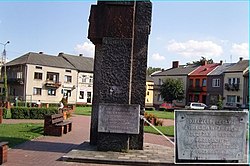Przysucha
| Przysucha | ||
|---|---|---|

Monument on Main Square
|
||
|
||
| Coordinates: 51°22′N 20°37′E / 51.367°N 20.617°E | ||
| Country |
|
|
| Voivodeship | Masovian | |
| County | Przysucha County | |
| Gmina | Gmina Przysucha | |
| Established | 15th century | |
| Town rights | 1710 | |
| Government | ||
| • Mayor | Tadeusz Tomasik | |
| Area | ||
| • Total | 6.98 km2 (2.69 sq mi) | |
| Population (2006) | ||
| • Total | 6,245 | |
| • Density | 890/km2 (2,300/sq mi) | |
| Time zone | CET (UTC+1) | |
| • Summer (DST) | CEST (UTC+2) | |
| Postal code | 26-400 | |
| Area code(s) | +48 48 | |
| Car plates | WPY | |
| Website | http://www.przysucha.umig.gov.pl | |
Przysucha [pʂɨˈsuxa] is a town in Poland. Located in historic Lesser Poland, it is part of the Masovian Voivodeship, about 100 km southwest of Warsaw and 40 km west of Radom. It is the capital of Przysucha County, and the town 6,762 inhabitants (2004). Its name in Yiddish is פשיסחא or פשיסכא (pronounced: Pshiskhe). In the past, it was home to a number of Hasidic Rabbis, such as The Holy Jew and Simcha Bunim of Peshischa.
Przysucha is located on the Radomka river, along national road nr. 12 (which in the future will make Expressway S12). Rail station Przysucha is located in the village of Skrzyńsko, on the line from Radom to Łódź.
First mention of Przesucha, as it was known then, comes from 1415. In the early 16th century, the village belonged to the Morsztyn family. Przysucha had a public house, a watermill, and a forge, and it belonged to the parish of Skrzyńsko. On December 11, 1710, upon a royal privillege, issued by King Augustus II the Strong, artisans were allowed to settle in the town, and a weekly market was established. Later on, two markets a week were permitted, and a manufactory was opened in town, along the Radomka river.
German artisans from Silesia and Saxony founded in the early 18th century a settlement called Czermno, which today is part of Przysucha. In Przysucha itself, the number of Jews rapidly grew. At that time, the town was a major center of Hasidism. In 1777, Przysucha had 39 German, 85 Jewish, and 29 Polish houses. The town was divided into three parts - Germans lived in Czermno, Jews in Przysucha, and Poles - in Urszulin. Przysucha also was one of centers of early industry. In the late 18th century, it had a blast furnace, a sawmill, and a paper mill. Since its origins to 1795 Przysucha belonged to Sandomierz Voivodeship.
...
Wikipedia


